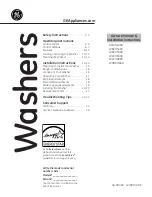
15
800168
Section 3 Troubleshooting
© Copyright, Alliance Laundry Systems LLC – DO NOT COPY or TRANSMIT
To reduce the risk of electric shock, fire, explosion, serious injury or death:
• Disconnect electric power to the washer before servicing.
• Never start the washer with any guards/panels removed.
• Whenever ground wires are removed during servicing, these ground wires must be
reconnected to ensure that the washer is properly grounded.
W003
WARNING
4. NO MOTOR ROTATION, OR DRIVE FAILURE CODE “E:DF” ON ELECTRONIC DISPLAY
UNITS
NOTE: Verify that motor is receiving proper voltage. Disconnect electrical power to washer.
TEST PROCEDURE
a. At the rear of the washer, remove the lower access panel.
b. Reach in through the access panel opening and disconnect motor wire harness from motor.
c. Using an Ohmmeter, measure resistance at the terminals on the motor. Refer to
Table 1
.
d. Replace motor if there is an open circuit on tach input (terminals 6-7) or winding circuits (terminals 1, 2 and
3), or if there is continuity between any terminal and the motor housing.
e. An open circuit between terminals 4 and 5 indicates a stuck or worn brush. Refer to appropriate service
procedure below.
SERVICE PROCEDURE: STUCK BRUSHES
a. Remove motor from washer. Refer to
Paragraph 58
.
b. Using a flashlight, view brushes through holes in motor end shield. Refer to
Figure 11
.
c. Inspect both brushes to determine if either brush braided wire is binding the brush movement. The braided
wire might be snagged on the seam in the corner of the metal brush holder. Refer to
Figure 11
.
NOTE: The copper braided wire should be located in the center of the brush assembly. If the braided wire
has fallen to the bottom of the brush, it will cause binding.
d. After determining which brush assembly is binding, carefully use the tip of a small screwdriver to unsnag
and reposition the braided wire. Refer to
Figure 12
. Make sure spring is making unobstructed contact with
the end of the brush. Rotate armature by hand to assure that brushes are seated.
e. Recheck resistance between motor terminals 4 and 5 to verify the brush position has been corrected.
f. Reinstall motor in washer.
g. Run washer through cycle to verify proper operation.
Motor Resistance Values
TACH INPUT
Terminals 6-7
Approximately 15 Ohms
BRUSHES
Terminals 4-5
Less than 70 Ohms
WINDING
Terminals 1-3
Approximately 1.1 Ohms
WINDING
Terminals 1-2
Approximately 2.0-2.4 Ohms
WINDING
Terminals 2-3
Approximately 3.4 Ohms
NOTE: Resistance values may vary depending on type of Ohmmeter used.
Table 1
















































